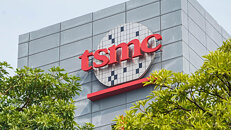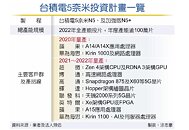Tuesday, May 12th 2020

TSMC 5 nm Customers Listed, Intel Rumored to be One of Them
TSMC is working hard to bring a new 5 nm (N5 and N5+) despite all the hiccups the company may have had due to the COVID-19 pandemic happening. However, it seems like nothing can stop TSMC, and plenty of companies have already reserved some capacity for their chips. With mass production supposed to start in Q3 of this year, 5 nm node should become one of the major nodes over time for TSMC, with predictions that it will account for 10% of all capacity for 2020. Thanks to the report of ChinaTimes, we have a list of new clients for the TSMC 5 nm node, with some very interesting names like Intel appearing on the list.
Apple and Huawei/HiSilicon will be the biggest customers for the node this year with A14 and Kirin 1000 chips being made for N5 node, with Apple ordering the A15 chips and Huawei readying the Kirin 1100 5G chip for the next generation N5+. From there, AMD will join the 5 nm party for Zen 4 processors and RDNA 3 graphics cards. NVIDIA has also reserved some capacity for its Hopper architecture, which is expected to be a consumer-oriented option, unlike Ampere. And perhaps the most interesting entry to the list is Intel Xe graphics cards. The list shows that Intel might use the N5 process form TSMC so it can ensure the best possible performance for its future cards, in case it has some issues manufacturing its own nodes, just like it did with 10 nm.
Source:
ChinaTimes
Apple and Huawei/HiSilicon will be the biggest customers for the node this year with A14 and Kirin 1000 chips being made for N5 node, with Apple ordering the A15 chips and Huawei readying the Kirin 1100 5G chip for the next generation N5+. From there, AMD will join the 5 nm party for Zen 4 processors and RDNA 3 graphics cards. NVIDIA has also reserved some capacity for its Hopper architecture, which is expected to be a consumer-oriented option, unlike Ampere. And perhaps the most interesting entry to the list is Intel Xe graphics cards. The list shows that Intel might use the N5 process form TSMC so it can ensure the best possible performance for its future cards, in case it has some issues manufacturing its own nodes, just like it did with 10 nm.


19 Comments on TSMC 5 nm Customers Listed, Intel Rumored to be One of Them
There'll be pretty slim pickings for others once Apple, Huawei & others have had their fill.
I'd expect NVIDIA to be bigger on Samsung 4nm & 5nm than they are on their 7nm or 8nm.
This time round, it'll probably be GA100 and GA102 on TSMC 7nm EUV. GA103 on TSMC 7nmP. All the volume chips definitely on Samsung.
Hopper I'd expect GH100 and GH102 to be on TSMC 5nm EUV (not the custom high power version AMD have), and everything else on Samsung. Next architecture after that, it could be just Gx100.
This is great for foundry competition IMO. It'll drive Samsung to improve the peformance versions of their new smaller nodes, and might finally get Intel to throw enough money at its foundry problems to get things moving.
They will need several years to turn this around, and their recent attempts are all bandaids. Anything 10nm for consumer you can safely say will be super low yield or low-power/performance. Alder Lake confirms that for true performance they would rather still grab 14nm cores.
This means that all this 7nm and up roadmap we have seen until now is built on air. Or all the 10nm tweaks are just PoCs... and they're about to bring us the real deal. (lol)
There are many other ventures Intel still has... but whether that will carry their fab business... not so sure.
Apple and TSMC did the same thing with iPhone X/Xs. They OWNED the 7nm node, back when AMD used the terrible 12nm GLOFO.
3000 series was the first to use 7nm TSMC, over ONE YEAR after Apple was spitting 7nm arm SOCs out to the public. 2000 series would never have used that terrible GLOFO FAB if TSMC 7nm was ready, but it was not - Apple owned the production at this point.
Every single new TSMC node, Apple gets prio for ~1 year. Google it. It's their biggest customer.Intels TSMC orders are for GPUs, not CPUs.
I don't know specifically what there are though
Lisa Su is probably the biggest asset AMD has, she has a set of engineering accomplishments longer than my arm and is the author of many patents. Compare to Bob Swan. CFO turned CEO. dime a dozen MBA.
Like this from 2002 :
The single biggest(?) reason IMO for Intel being in a position where they are now is because of their "focus" on milking their base relentlessly, especially when there was little to no competition from AMD. They could've easily launched a hexa core mainstream chip a decade back but chose not to because they thought users don't need more than 4 cores! Their ULV chips were even more ridonculous, dual core i7 till 2017 IIRC :shadedshu:
The fact is Intel relied too much on exploiting the latest process node to extract maximum margins for their lineup. At one point, when AMD launched 25x 20 (efficiency) target, in 2014 AMD was stuck on 28nm for their APU & 32nm for the rest of of the FX lineup, while Intel already moved to 14nm FF with a 2-2.5 node lead.
AMD even in the past have shown that they've competed well with Intel on similar nodes, pre Bulldozer, or even beaten them at times with a node disadvantage. If Intel's only/main strategy was based on outcompeting their rivals with a better node than they obviously never thought of that thing called Physics!
Intel was originally founded by a couple of chemists and a physicist. One of those guys (Andy Grove) was the CEO until the late 1990s. To give an idea of what he was about, I found this :
"People here aren't afraid to speak up and debate with Andy."[16] They termed this style "constructive confrontation."[13] According to Grove's successor at Intel, Craig Barrett, "It's give and take, and anyone in the company can yell at him. He's not above it." Grove insisted that people be demanding on one another, which fostered an atmosphere of "ruthless intelligence."
Once Grove left, the bean counters took over. By bean counter, I mean the people who make strategic decisions based on financials and little else. Rather than doing the hard work of being an innovative engineering company, they do things like what you talked about. This happens to most big corporations at some point. The hard working, smart, innovative people who build it and make it successful move on or pass away, and these worthless money changer / bean counters move in. It happens to every big company at some point and if AMD is around long enough and gets big enough, it'll happen to them too.
Once again, there is nothing wrong with bean counting. The bigger problem is bean counting and nothing else... it is the loss of industriousness & work ethic.
You cannot move past prior ruling. If you don't follow the rules, you lose track of which rules to follow.
It is like the socratic dilemma. Societies which uphold the law sector are amoral since people cannot behave without a moral compass. More laws don't mean more morality, in fact less.
This is the endeavour of creative minds versus established assets. If you tax more, creative minds lose. It is all a system level manufactured result. You keep overturning the modus operandi.
There was an nvidia developer giving a conference on neural networks. What he stated was, if the system selects for algorithms that are ranked 'for' the most favourable candidate, you didn't develop the best optimised algorithms. They got lost in one to one with the known best. Instead, if you kept comparing them in a secondary position 'equal or better' target, you suddenly developed secondary branches that further down the line toppled and improved upon the ranking leader.
I think Intel narrowed their focus. Suddenly, they lost track. Happens in a competitive medium if you mistake your opponent for your own image. The narrative shifts quickly when you start speaking for the whole and not just yourself. Your lose your voice.
What Intel can do, is return to Hyperthreading marketing. There was a time people didn't know past the purchase of performance. It was not an actual metric, but it was an Intel trademark. It was different than Intel trying to catch wind of its competition. It gives the narrative away.
MS CEO : Masters in engineering first, 10 years as an engineer, then MBA
AMD CEO : PhD in engineering with 15 years of experience as an engineer
TSMC CEO: Mark Liu, PhD in Electrical Engineering and Computer Science
Qualcomm CEO: Steve Mollenkopf 7 years as an engineer with Qualcomm, then went into engineering leadership, been with them since 1994
Nvidia CEO: Jen-Hsun Huang Masters in Electrical Engineering, co-founded Nvidia after 14 years of work as an engineer for LSI and AMD
And then there's Intel.
Edit: Despite my criticism of Intel, I am of the opinion that the pendulum is about to shift and by this time next year Intel will have effectively crushed AMD's performance lead and left them in the bargain bin. That's just my opinion based on what I'm seeing, time will tell.